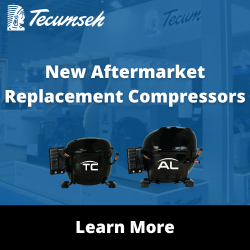- Refrigeration Equipment
- AC and Heating Equipment
- Indoor Air Quality
- Food Service
- Compressors
- Motors and Accessories
- Refrigerants and Chemicals
-
Controls and Electrical
- Thermostat
- Commercial Building
- Defrost Termination-Freeze Protection-Fan Switches
- Detector
- Electrical Devices and Accessories
- Flow Switch-Current Sensors
- Heating
- Humidity
- Motor Drives
- Pneumatic
- Pressure
- Supermarket Controls and Parts
- Temperature
- Timer
- Water Regulating Valve
- Zone Control and Wireless
-
Float Switch
-
Security Camera
- Parts and Components
- Supplies and Service
- New and Featured
- Job List Builder
Product Categories
-
Product Categories
- Refrigeration Equipment
- AC and Heating Equipment
- Indoor Air Quality
- Food Service
- Compressors
- Motors and Accessories
- Refrigerants and Chemicals
- Adhesives-Threadlock View
- Coil Cleaner View
- Coil Coating View
- Coil Degreaser View
- Degreaser View
- Electric Contact Cleaner View
- Food Grade Silicone View
- Glycols View
- Leak Detection View
- Leak Sealant View
- Lubricants View
- Pump Protector View
- Refrigerant Treatments View
- Solvent View
- Wasp and Hornet Spray View
- Zinc Spray View
- Controls and Electrical
- Thermostat
- Commercial Building
- Defrost Termination-Freeze Protection-Fan Switches
- Detector
- Electrical Devices and Accessories
- Flow Switch-Current Sensors
- Heating
- Humidity
- Motor Drives
- Pneumatic
- Pressure
- Supermarket Controls and Parts
- Temperature
- Timer
- Water Regulating Valve
- Zone Control and Wireless
- Float Switch
- Security Camera
- Parts and Components
- Supplies and Service
- New and Featured
- Job List Builder
- New & Featured
Making Sense of EPA Refrigerant Use Restrictions
How EPA Regulations Affect The Use of R-22
As of January 1, 2020 the production and importation of R-22 ended due to provisions in the Clean Air Act designed to phase out refrigerants with ozone depleting potential by 2030. Importantly, this phase out DOES NOT affect existing R-22 inventories including reclaimed R-22, the use of R-22, or systems currently operating with R-22. This means that R-22 will still be available to service existing equipment, especially as retrofits and refrigerant conversions continue to make quantities of R-22 available.
Is R-22 Refrigerant Gone?
No - R-22 is an excellent refrigerant with many uses and a significant installed base in both refrigeration and HVAC applications. According to one estimate, as of 2017 there were 60-70 millions systems in the U.S. operating with R-22 refrigerant. For this reason we understand that it may not be feasible for all systems to be immediately replaced or converted to alternate refrigerants. The details below will walk you through the options when deciding how to proceed with a piece of equipment currently operating with R-22 refrigerant.

NOTE: It's useful to understand the background, rules, and penalties for non-compliance, as described in this section. When you are ready to learn more about how to proceed, click the link on the three options below to help decide whether you should maintain, retrofit, or replace your current system.
Newly Manufactured R-22 Allocation
Existing Inventories and reclaimed R-22 needed to satisfy demand


EPA Rules You Need to Know SNAP (Significant New Alternative Policy) Program
In June 2013, as part of the President's Climate Action Plan, the EPA utilized the Significant New ALternatives Policy (SNAP) to allow the use of environmentally-safe refrigerants to replace ozone-depleting CFCs, HCFCs, and high GWP HFCs. As a result, the EPA reviewed refrigerant use applications to determine if viable lower GWP alternative refrigerants were available. When suitable alternatives are identified, they are approved for use in specific applications.
Applications that have not had SNAP rule changes restricting or prohibiting the use of refrigerants include:
- Retail Food Refrigeration
- Vending Machines
- Household Refrigerators
- Cold Storage Warehouses
- Comfort Cooling Chillers
Applications that have had SNAP rule changes include:
- Residential and Light Commercial A/C, Heat Pumps
- Industrial Chillers
- Commercial Ice Machines
- Ice Skating Rinks
- Industrial Process A/C
- Residential Dehumidifiers
- Refrigerated Transport
- Water Coolers
- Very Low Temperature Refrigeration
Therefore, refrigerants such as R-134A, R-404A, R-407A, R-407C, R-507, R-422B, and R-410A can continue to be used in these applications. There are no regulations restricting the manufacture of these refrigerants, so equipment owners can be confident in their ability to obtain and use these refrigerants for the life of their installed equipment.
How Section 608 of the EPA's Clean Air Act Affects Refrigerant Decisions
A recent amendment to Section 608 extends the existing regulation to HFC refrigerants and, effective Jan. 2019, lowers the leak rate threshold in equipment containing 50 or more pounds of any refrigerant. It also requires owners/operators to repair leaks that exceed the threshold and perform verification and follow-up inspections to confirm that leaks are repaired.

Penalties For Non-Compliance Can Be Significant
The EPA can assess civil penalties up to $44,539 per day, per violation, for non-compliance.
Section 608 Leak Rate Thresholds
| System Type | Current Allowable Leak Rate | Effective 1/1/19 |
|---|---|---|
| Industrial process refrigeration | 35% | 30% |
| Commercial refrigeration | 35% | 20% |
| Comfort cooling | 15% | 10% |
NOTE: Each independent refrigerant circuit in a system is considered a separate system for leak rate applicability.








